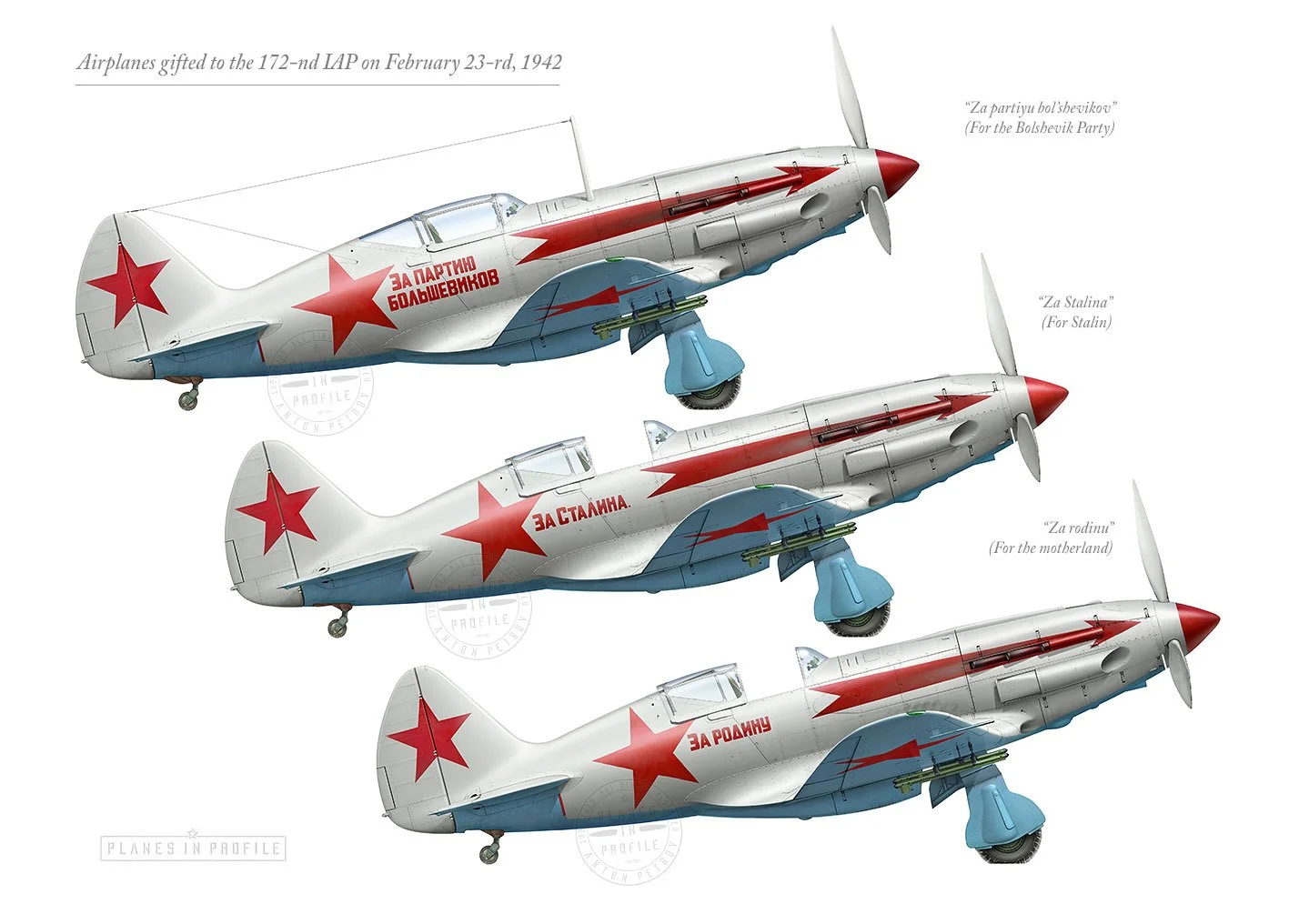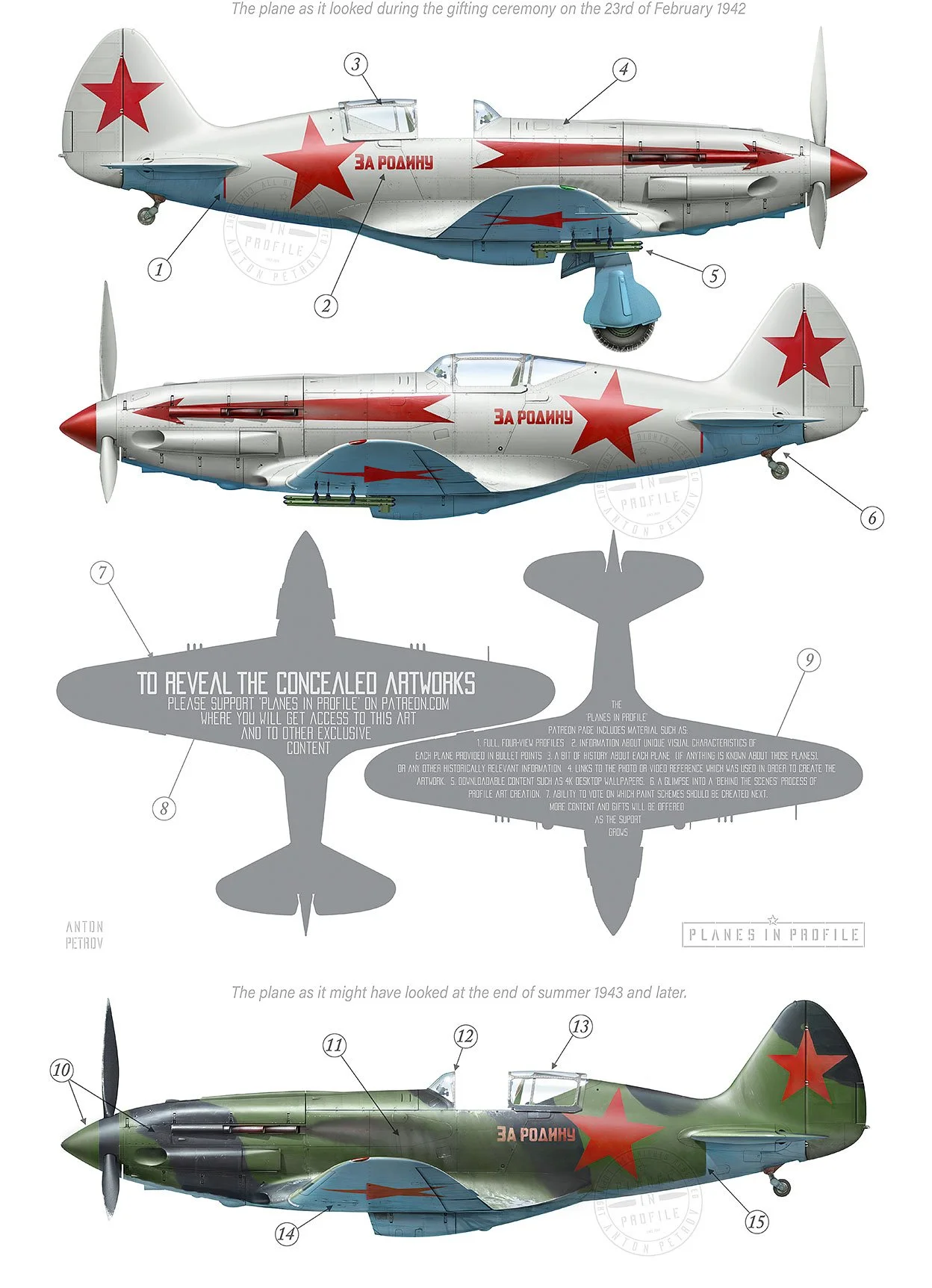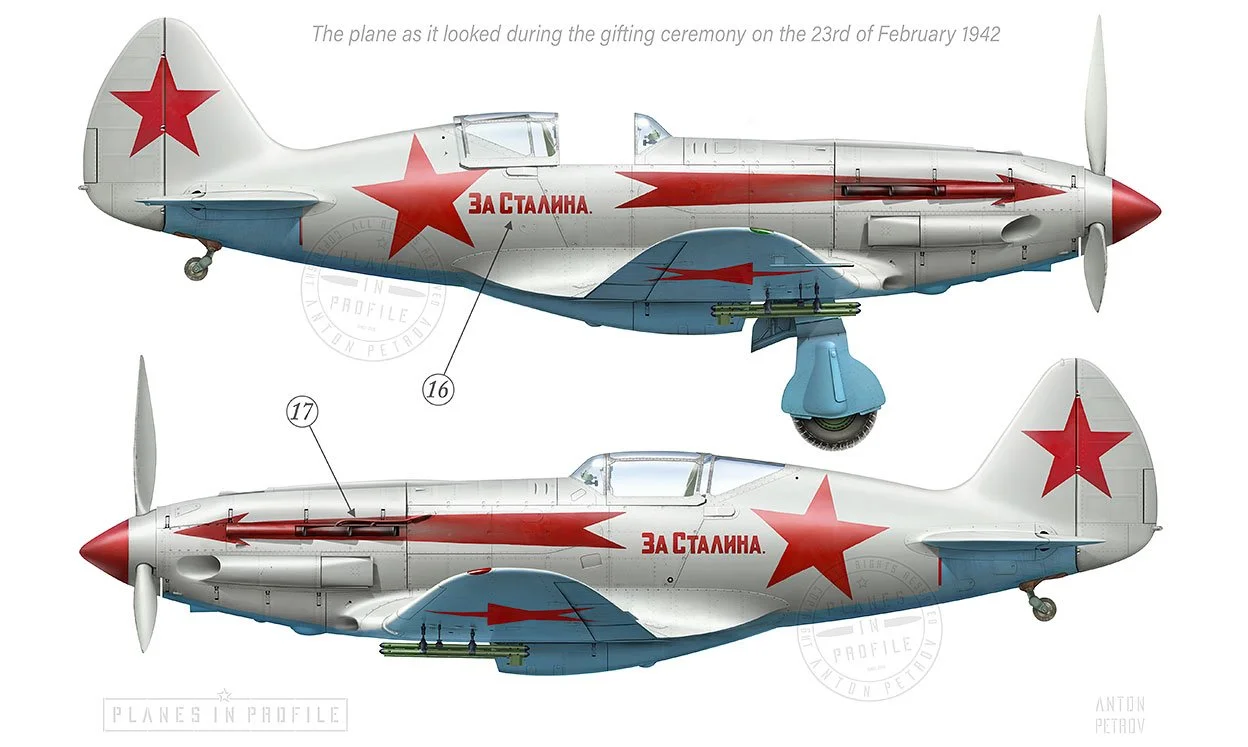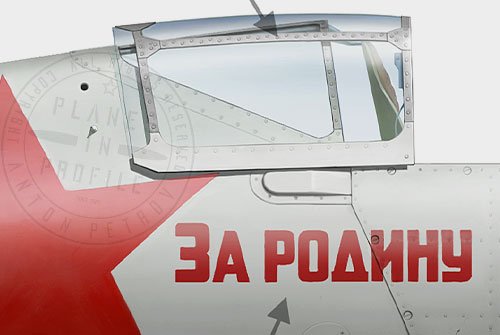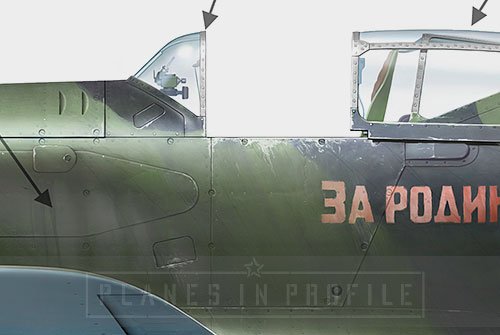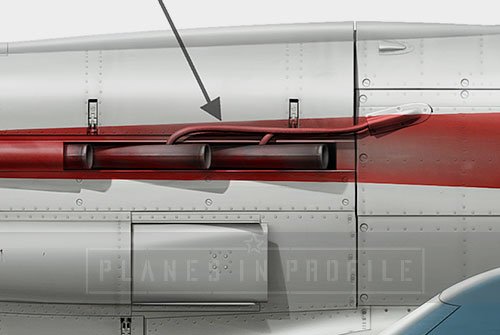Rybalko’s “Za rodinu” and “Za Stalina”
MIKOYAN & GUREVICH, MIG-3 (Late)
172-nd IAP, 23-rd of February, 1942, (likely to have been gifted to the regiment at) “Stalin” Aircraft Repair Plant number 1, Moscow,
and
122-nd IAP, 201-st IAD, 1st Air Army, (Soviet) Western Front. August 1942. Rzhev-Sychevsk offensive.
Flown by Lieutenant Vitaliy Viktorovich Rybalko ((future)an Ace with 7 victories)
On the 23rd of February 1942, the workers of Moscow’s Aircraft Repair Plant number 1 named after Stalin, have gifted three airplanes to the aviators of the 172nd IAP. These were MiG-3 airplanes, adorned with large red arrows and inscriptions which read ‘Za Rodinu’, ‘Za Stalina’ and ‘Za Partiyu Bol’shevikov’. Surprisingly though, 172nd IAP did not have any pilots who were trained to fly the MiG-3, and therefore not longer than a month later these machines were passed on to the 122nd IAP, which was being re-equipped at the time and received (second-hand?) planes from various regiments. Even though 122nd IAP only had 5 pilots left in it at that time, the regiment ended up with 80 airplanes, offering plenty of choice for the 5 airmen. It’s not surprising that V.V. Rybalko, who was one of the five pilots, chose to try out the three striking-looking machines with the red arrows.
Flying from the muddy airfield of Ramenskoe, mainly as Pe-2 bomber escorts, Rybalko flew the ‘Za Stalina’ airplane in the spring of 1942, but it was found to be faulty, so Rybalko was offered the other two planes to choose from for the following sorties. Rybalko recalled his reply to this offer in an interview published on https://statehistory.ru:
‘I will fly “For the Motherland’”(За Родину), but I will not fly “For the Bolshevik Party”(За партию большевиков), since its too heavy’
and then he added jokingly to the interviewer : ‘It’s a good thing that there were no NKVD officers to hear it!’ :)
The reason that “For the bol’shevik party”was ‘heavy’ is because, unlike the other two machines, it was equipped with a radio which, according to Rybalko, weighted quite a bit.
So Rybalko chose to fly the “Za rodinu” as his next airplane. The sortie that followed involved yet another escort mission, this time escorting nine Pe-2 (Peshkas). Commander of the squadron Romanenko was unable to take off, and while taxying, Korobkov overheated his engine. Korobkov was able to take off but had to land again because he had oil spilling along the side of his plane’s fuselage. So Rybalko was left to escort the bombers alone. On the outskirts of Ramenskoe, at a hight of 1000 meters, the group was met by 4 ‘Heinkel-113’ fighters (Please note that Rybalko must have made a mistake here, he probably meant Me-109Fs?) [1] which in Rybalko’s opinion were Luftwaffe’s best fighters in terms of maneuverability. Rybalko had no choice but to engage the enemy, in an attempt to prevent them from getting to the bombers. Though Rybalko flew without the high altitude oxygen mask and though he was no Ace yet at that time, he managed to force the enemy to battle in the verticals and lead them away from the bombers to a hight of 7000meters where his MiG-3 high altitude fighter was in “its element” and the Heinkel (Me-109Fs?) fighters were not as much of a threat any more. The enemy must have been low on fuel because the fight didn’t last long and the enemy left without any casualties on either side. Though Rybalko didn’t manage to shoot any of them down, he did fulfil his duty as an escort fighter - he prevented the enemy from getting to the bombers.
Rybalko did go on to become an Ace eventually, saying in his interview that he scored a total of 14 victories [2] adding that ‘ It’s not too few for those whose job was to be an escort’.
‘Za Rodinu’ was flown by Rybalko in the spring and summer of 1942, the period which included the Rzhev-Sychev summer offensive operation in which Rybalko took part. During some of that time 122nd IAP was already equipped with Yak planes. It is difficult to know when exactly Rybalko started to fly the Yak airplanes, but all of his confirmed victories (7 of them [2]) were scored when flying a Yak plane.
Rybalko’s full interview which the info above was sourced from, can be read here: https://statehistory.ru/books/Artyem-Drabkin_YA-dralsya-na-istrebitele--Prinyavshie-pervyy-udar--1941-1942/10#fbautid_60
Noteworthy Visual Characteristics
“Za rodinu”
The plane as it looked during the gifting ceremony on the 23rd of February 1942
General. This striking looking plane looks freshly painted in the photo reference. The stars are in the usual 6 positions. The airplane is adorned with two large red arrows on each side of the fuselage - a decorative element, these arrows are not associated with identification markings of any particular unit. The shade of red colour of the arrows and the spinner seems to differ slightly from the red of the stars and differs very slightly from plane to plane. This could be simply because of the bad quality of the photograph.
Having been gifted by an ‘Aircraft repair plant’ it is possible that these were not brand new airplanes, but refurbished machines, possibly veterans of the ‘Battle for Moscow’. Regardless of whether this was the case or not, there is a high probability that these were some of the last MiG-3s to be built, in which case they were probably equipped with only 2 machine guns.
About 315 (or 350 according to other sources)late production MiG-3s were armed with 2 x 12.7mm caliber UBS machine guns, with ammunition increased from 300 to 700 rounds each. 215 of them were equipped with 2 x RO-82 rail launchers for firing RS-82 rockets, same as can be seen in the photos of “Za patriyu bol’shevikov”
About 30 (or 50 according to other sources) late production MiG-3s were armed with 2x 20mm caliber ShVAK cannons instead. [3]
As far as the external appearances go, the 2-gun version of the airplane probably looked the same externally as the 3-gun version, it just lacked the extra gun which fired through the middle slot, but it’s likely that the middle (external) slot was still present.
1. The vertical red lines (on both sides of the plane) under the horizontal stabilisers indicate the area for lifting plane’s tail during repairs.
2. ‘За родину’ (Za rodinu), translates to ‘For the motherland’
3. The top parts of the metal canopy frame appear to be darker than the white colour of the airplane, but not as dark as one would expect green or black to be. These were probably unpainted, bare metal , silver/aluminium in colour.
4. Note the absence of the antena mast and any antena wires. ‘Za rodinu’ was not equipped with a radio.
5. The plane was equipped with the RO-82 rocket launch racks.
Based on THIS PHOTO it appears that the rocket launchers were darker than AMT-7 blue colour of the airplane’s lower surfaces. They were most likely green and black as per THIS and THIS photo reference on Scalemodels.ru
The RS-82 rockets were not loaded onto the launchers during the gifting ceremony, nor are they visible in the photo from spring 1942, therefore I didn’t include them in the illustration above.
6. Note the non-retractable tailwheel. The base of the wheel shaft is protected with a canvas or leather covering.
7. This was a late type MiG-3, with slats.
8. The white paint that the plane is painted with might not have been MK-7 temporary/removable white paint, but a more permanent version of white paint instead.
This rationale is based on the fact that in the ‘summer livery’ version of this airplane the large red arrow seems to be missing and the inscription ‘Za rodinu’ appears to be partially white. It seems most logical to presume that the reason the inscription is partially white is because some of the red paint has rubbed off of it exposing some of the original white underneath it and that the large red arrow is missing because it has been painted over when the original ‘white airplane’ was given a coat of green/black paint.
The idea that the plane was painted with temporary/removable MK-7 white paint which was washed off to reveal the green/black camouflage, seems less logical in the light of the two observations mentioned above.
9. The stars on underside of the wings appear to be quite large. The front point of the star extends up to the slat, the back points possibly extended onto the ailerons.
The plane as it might have looked at the end of summer 1943.
General. The plane looks like it was painted over with AMT-4 (Dark Green) and AMT-6 (Black). It looks quite weathered in the photo, showing areas which appear to be spills and streaks (or possibly brush marks?).
10. The spinner and the red arrow look like they were painted over by the AMT camo. colours.
11. Note the vertical lines in the area of the central fuel tank opening. These were probably fuel spills.
12. The canopy frame appears to be lighter than the green and black colours of the airplane. This helps to confirm that it might have been unpainted, bare metal (silver/aluminium in colour basically).
13. Note the small rectangular cut-out in the front/bottom corner of the moving part of the canopy. Also note the fact that the canopy is open. Rybalko in his interview said that he usually flew ‘Za rodinu’ with the canopy open. MiG-3 pilots often chose to fly their planes with the canopy open due to the heat and to the fumes which otherwise filled the cockpit sometimes.
14. Note that the RO-82 rocket racks have been removed.
15. The red lines under the horizontal stabilisers might have been painter over. It looks like they were painted over on the “Za partiyu bolshevikov” as can be seen in THIS PHOTO.
“Za Stalina.”
The plane as it looked during the gifting ceremony on the 23rd of February 1942. This airplane, after it was transferred to the 122nd IAP (from 172nd IAP), was flown by Rybalko in spring 1942, before he flew “Za rodinu”.
General. The plane is almost identical to “Za rodinu” except for slight variations in the ‘arrow’ design/placement as well as the following:
15. “За Сталина.” (Za Stalina.), translates to “For Stalin”. Note the dot at the end of ‘Stalin’. There is no dot in the inscriptions on the other two airplanes.
16. This airplane was equipped with an inert gas pipe. It is clearly visible in THIS PHOTO. Looking at the photos of '“Za rodinu” it doesn’t appear that “Za rodinu” had an inert gas pipe.
Here are a few closeup images to help illustrate the points above. Full set of close-up images is On Patreon
Footnotes
[1] It is rather strange that Rybalko in his interview mentioned engaging Heinkel’s He-113 fighters. These fighters did not serve operationally. Only around 12 machines were built and it was due to German propaganda that the myth of the Luftwaffe being equipped with these ‘super fighters’ was created. American and RAF pilots were also known to misidentify the later Me-109 models as He-113. You can read more about this HERE
[2] Please note that the 14 victories are according to Rybalko. I usually use Mikhail Bykov’s research in determining confirmed victories of the Soviet pilots. In his book called ‘All of Stalin’s Aces’ published by Yauza, M. Bykov indicates that Rybalko had 7 confirmed victories. (on page 1020)
[3] The info about the 2-gun MiG-3s is based on the info contained on https://airpages.ru/eng/ru/mig3arm.shtml. Also, an excellent page about MiG-3’s armament was created by Massimo Tessitory http://massimotessitori.altervista.org/sovietwarplanes/pages/mig3/guns.html
Links To the reference images and videos
Photos of both planes together
Photos and more info can be found on Massimo Tessitori’s Sovietwarplanes.com site :
http://massimotessitori.altervista.org/sovietwarplanes/pages/mig3/whslogan1.html
The first link below is to a photo which is of pretty good quality, but unfortunately it looks like it has been touched up by paint (you can tell by looking at the ground). So it might be a bit misleading because it also looks like the airplanes were brush painted, when in reality that’s probably the brush marks of the artist who cleaned up the photo traditionally before the days of Photoshop.
Photos of “Za rodinu”
http://ava.org.ru/iap/122/mig-3_za-rodinu.jpg
http://airaces.narod.ru/all9/rybalko9.jpg
Photos of “Za Stalina.”
http://massimotessitori.altervista.org/sovietwarplanes/pages/mig3/fotobian23.JPG
All the work presented on this is page is subject to updates and revisions in the light of new information which might present itself. If you have any new information relevant to this page or disagree with anything that's presented here, then please feel free to contact me through the Planes in Profile Facebook page. Thanks:)


